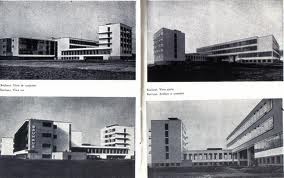I shall now be looking into one of the most influential art
and design movements within history. The Bauhaus. It is important to note that the Bauhaus did
not just focus on fine arts or 3d design but instead as a school it wanted to
focus on variety.
Bauhaus was one of the most definitive design movements of
the modern age, reaching its peak between the 2 world wars. The word Bauhaus
name, mostly translated from German, means house of construction or school of
building, even though there was no architecture as such within the first years
of its existence. Bauhaus was a new type of art school, historically European
art academies thought each design subject separately, the Bauhaus offered
foundation training in many design disciplines, they believed in verity.
Understanding mass production was part of the curriculum and the school sought
to develop students with art and craft whilst embracing new technologies. It
was also the beginning of the art school as an alternative way of life. Germany
at that time was a rather conservative place though.
Bauhaus initial idea was to reject the idea of decorative
art and replace it with minimalism in mass production. Its main inspiration
came from the De Stijl movement which was a modernist movement founded by Theo
Van Doesbeurg, its characteristics were the use of primary colours and
horizontal and vertical lines and rectangular forms. The Bauhaus focused on
intense form, absolute clarity, and distinctive visual identity.
Bauhaus was clearly a big influence on graphic design,
looking at our present day graphic design we still constantly see the
influences Bauhaus. As with other movements we notice that movements emerge
from movements. And a very important graphic design movement emerged from the
Bauhaus which was the New Typography which basically shared many
characteristics with Bauhaus, but continued experimenting with type to create
more influential pieces.



No comments:
Post a Comment